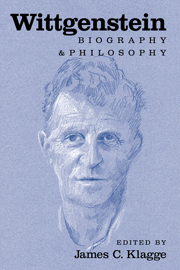Book contents
- Frontmatter
- Contents
- Contributors
- Editor's Preface
- Biography and Philosophy
- Wittgenstein
- Wittgenstein and the Mind's Eye
- Deep Disquietudes: Reflections on Wittgenstein as Antiphilosopher
- The Sleepy Philosopher: How to Read Wittgenstein's Diaries
- Letters from a Philosopher
- Wittgenstein and Reason
- Wittgenstein and the Idea of Jewishness
Wittgenstein and the Mind's Eye
Published online by Cambridge University Press: 27 March 2010
- Frontmatter
- Contents
- Contributors
- Editor's Preface
- Biography and Philosophy
- Wittgenstein
- Wittgenstein and the Mind's Eye
- Deep Disquietudes: Reflections on Wittgenstein as Antiphilosopher
- The Sleepy Philosopher: How to Read Wittgenstein's Diaries
- Letters from a Philosopher
- Wittgenstein and Reason
- Wittgenstein and the Idea of Jewishness
Summary
The significant verb in this description of drawings is show.
– Eugene Ferguson, Engineering and the Mind's EyeA proposition shows its sense.
– 4.022Propositions show the logical form of reality. They display it.
– 4.121What can be shown, cannot be said.
– 4.1212 – Ludwig Wittgenstein, Tractatus Logico-Philosophicus[The hinged railings] are stood upright as is made clear and obvious in the illustration because I cannot so well set it forth in words as I see it in my mind's eye. But the picture will show it.
– Guido da Vigevano, 1335, in Eugene Ferguson, Engineering and the Mind's EyeOn what kind of knowledge is engineering design based? How does an engineer solve problems, communicate ideas, and create designs? The engineer's ability to visualize an invention, to solve design problems by creatively altering configurations of its elements, calls for a kind of constructive, spatial, synthetic thinking that is also crucial for a certain type of scientific imagination. Before he studied philosophy under Bertrand Russell at Cambridge, Ludwig Wittgenstein's education was technical and scientific. His formal training and postgraduate research prior to approaching Russell to study logic were directed toward shaping the mind of a sophisticated research engineer. The visual thinking involved in the mathematical drawings of engineering design trains the mind's eye to picture how the elements of a structure function in combination with one another. This kind of visual thinking plays a critical role in the Bild theory of language in the Tractatus Logico-Philosophicus (hereafter Tractatus).
- Type
- Chapter
- Information
- WittgensteinBiography and Philosophy, pp. 53 - 97Publisher: Cambridge University PressPrint publication year: 2001
- 13
- Cited by



